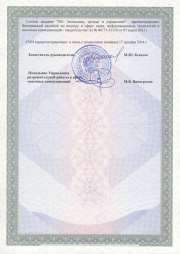|
DOI: 10.25136/2409-8647.2022.4.38996
EDN: MCDNRP
Received:
21-10-2022
Published:
06-01-2023
Abstract:
This article discusses the problems of estimating the projects cost for decommissioning nuclear and radiation hazardous facilities based on BIM data. The software developed at Nuclear Safety Institute of the Russian Academy of Sciences for planning and analyzing decommissioning facilities at the pre-project stage processes is described. In particular, the software main functions are demonstrated: evaluation of the dismantling and decontamination works cost, forecasting the waste generated volume, technological processes planning and the safe waste management cost evaluation, results analysis taking into account the uncertainty of the initial data and sensitivity analysis. The scientific novelty consists in the development by a team of authors of software for financial and economic planning of decommissioning of nuclear and radiation hazardous facilities on the basis of digital information 3D models of objects being created. The need for such development is conditioned by the requirements for systematization and analysis of data on nuclear waste at the preparatory stage for the selection of effective technologies for dismantling and decontamination works and management of radioactive waste, as well as to improve the efficiency of individual decommissioning projects and the Federal Target Program "Providing Nuclear and Radiation Safety for 2016-2020 and for the period up to year 2035" generally.
Keywords:
radiation hazardous facilities, radioactive waste, decommissioning, decontamination, cost estimation, digitalization, Building Information modeling, software development, Federal target program, building information model
This article is automatically translated.
You can find original text of the article here.
IntroductionCurrently, the problems of liquidation of nuclear and radiation hazardous facilities (NWS), the operation of which has been discontinued for its intended purpose, as well as the management of spent nuclear fuel and radioactive waste (RW) are key for the sustainable development of nuclear energy in the future. In order to solve the priority problems of the "nuclear legacy" on the territory of the Russian Federation, the Federal Target Program "Ensuring Nuclear and Radiation Safety for 2008 and for the period up to 2015" (hereinafter referred to as the Federal Target Program NRS–1) was implemented [1] and the Federal Target Program "Ensuring Nuclear and Radiation Safety at the 2016-2020 and for the period up to 2035" (hereinafter referred to as the Federal Target Program YARB–2) [2], the total budget of which is about 600 billion rubles. The world practice of planning for decommissioning of nuclear power plants demonstrates great difficulties in terms of the accuracy of planning and estimating the cost of such projects at the pre-project stage, which, in turn, is necessary when developing and approving large-scale medium- and long-term programs with the predominant participation of the state. In this regard, the tasks of developing a methodology for improving the accuracy of estimates, including methods for collecting and systematizing data on the NAR, methods for estimating the cost of work, project management, risk analysis, are becoming urgent [3, 4]. The experience of implementing the activities of the Federal Target Program YARB-1 and Federal Target Program YARB-2 also confirms this problem. This is mainly due to the specifics and uniqueness of each nuclear installation, the history of its operation, the absence or inconsistency of project documentation with the actual condition of the facility, lack of experience and underdevelopment of technologies for performing dismantling and decontamination work, the scale of projects and the complexity of their management, inaccuracy and incompleteness of information about the radiation characteristics of facilities. Over the past 10 years, digital technologies have been actively developing in Russia and the world in various sectors of the economy, and, in particular, in construction. Technologies of digital 3D and information modeling of objects are widely used, including for the purposes of monitoring the condition of the object and planning dismantling works and estimating the volume of waste generation of various categories [5, 6]. To plan the liquidation of a nuclear power plant, an information model of a building (BIM – building information model) is created in specialized software, which allows you to systematize data on the building structures of the object, their mass-dimensional characteristics, condition and degree of contamination and other significant characteristics. The main data sources for building BIM are: - full-scale surveys and measurements by ground-based laser shooting technology using a laser scanner with a set of geodetic stamps; - analysis of available project and other documentation on objects; - analysis of the results of integrated engineering and radiation monitoring (CIR); - the results of additional research conducted during the development of BIM. 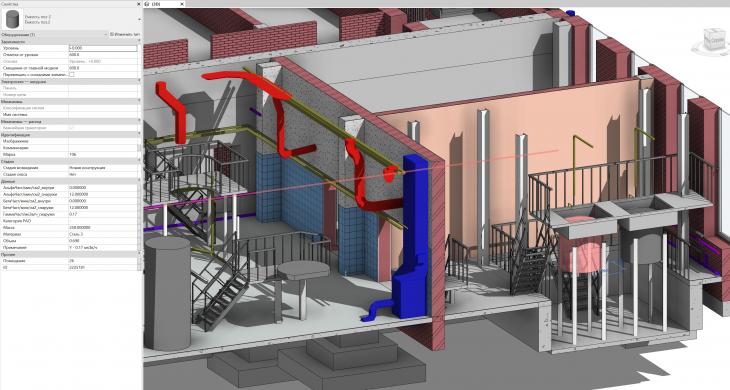
Figure 1 – View of the elements of building structures in BIM with indication of the characteristics of the object [5] 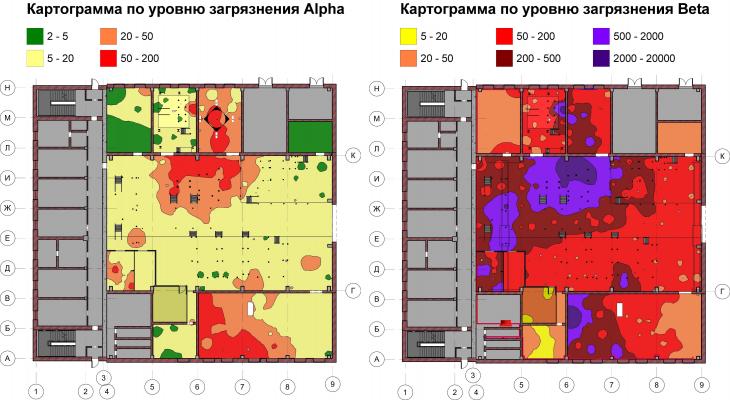
Figure 2 – A view of the radiation pollution cartogram in BIM, constructed by interpolation based on pollution points from KIRO, part./cm2?min. [5] Figures 1 and 2 demonstrate a general view of the data being entered and visualized in BIM for YAROO. The experience of implementing BIM technology shows its effectiveness in terms of collecting and systematizing data on building structures and contamination of various surfaces and equipment of the YAROO [6]. The next step for the formation of effective management decisions, the choice of optimal technologies and the assessment of the necessary resources for the decommissioning of facilities is the development of methods of financial and economic planning and analysis of current and long-term security, based on data collected in the framework of information modeling. In Europe, similar tasks are being solved, for example, in the project "PLEIADES, the Smarter Plant Decommissioning", within which an ecosystem is being developed for systematization of data and optimization of processes for high-tech [7]. The authors of this publication are currently engaged in the development of a methodology for solving the problems of financial and economic assessments of nuclear power plants in Russia, in particular, software is being developed for financial and economic planning and justification of the effectiveness of solutions for decommissioning nuclear power plants at the pre-project stage based on data from the digital information model of the facility. The automated solutions existing in Russia for the implementation of estimated calculations are primarily focused on the construction and demolition of facilities that do not have radiation contamination and a diverse range of waste, i.e. they are not applicable for decommissioning of nuclear power plants. At the moment, the software developed by the authors of the article allows solving the following tasks: - to carry out an assessment of the cost of work, as well as a detailed technical and financial and economic analysis for a given plan (sequence of technological operations) of decommissioning of the YAROO; - to develop an economic justification when choosing the optimal variant of the final state of the site or object; - evaluate the effectiveness of selected technologies for decontamination of contaminated surfaces and waste management; - to carry out a dynamic assessment of the necessary resources for the implementation of the decommissioning project, including the load on infrastructure and equipment (for example, waste management capacity;
- perform risk and uncertainty analysis of the project; - to assess the sufficiency of the initial data to perform cost estimation calculations (with a given accuracy) and form recommendations for data refinement. Assessment of the cost of dismantling and decontamination worksThe initial data for calculating the cost of dismantling works is a set of data (characteristics) of elements of building structures and equipment from BIM YAROO. The data is loaded into the software in tabular form, containing a list of elements of building structures and equipment, indicating their mass-dimensional characteristics and material, as well as the names of the work from the structure of the decomposition of work in accordance with the liquidation plan of the object. Note that in the software being developed, the names of elements in manual unloading (if this is not done in BIM) must be brought to a standardized form in accordance with the database (work reference) contained in the program. In this case, based on the name of the element, its characteristics and type of work (installation, dismantling, decontamination, etc.), the program will automatically select a suitable price for calculating the necessary resources (labor, material costs, etc.) and the cost of work. The calculation of the cost of dismantling works is based on the methodological recommendations of the Ministry of Construction and Housing and Communal Services of the Russian Federation, in particular Federal and Territorial Unit Prices, and a system of clarifying coefficients. The methodological and regulatory basis of calculations are the documents [8, 9, 10]. For all specific and high-tech types of work characteristic of most projects for decommissioning of nuclear power plants, in particular decontamination (cleaning of contaminated surfaces from radiation and chemical contamination) of building structures and equipment, a database of prices is formed based on market analysis of the supply market, analysis of estimates of similar works already performed or by the resource method. As a result of the calculation in the software module "Assessment of the cost of dismantling and decontamination works" (Figure 3), a number of summary tables are formed: - grouping of the cost of dismantling and decontamination works by cost items; - grouping of the cost of dismantling and decontamination works by the names of works from the structure of the decomposition of works in accordance with the plan of liquidation of the object; - detailed calculation of the cost and volume of necessary resources for each building element from BIM. 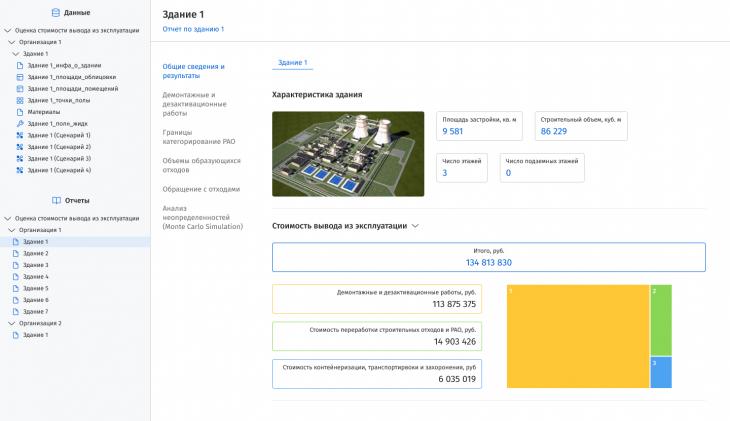
Figure 3 – Demonstration of a part of the program interface with visualization of the results of the cost assessment of dismantling and decontamination works Forecasting the volume of waste generation by type and categoryThe developed software predicts the volume of waste generation as a result of decontamination and dismantling works of building structures and equipment and their categorization by the level of radioactive contamination. The source of information for performing calculations is data on contamination of indoor surfaces and equipment from BIM. Based on the data on the radionuclide composition and activity of contamination of structures and equipment, numerical criteria for classifying the waste generated as waste with an increased content of radionuclides and radioactive are calculated. The regulatory framework for performing calculations is the Basic Sanitary Rules for Ensuring Radiation Safety (OSPORB-99/2010) [11] and the Decree of the Government of the Russian Federation dated October 19, 2012 No. 1069 "On Criteria for Classifying Solid, Liquid and Gaseous Waste as Radioactive Waste, criteria for Classifying radioactive Waste as Special radioactive Waste and Disposed radioactive Waste and Criteria classification of disposed radioactive waste" [12]. 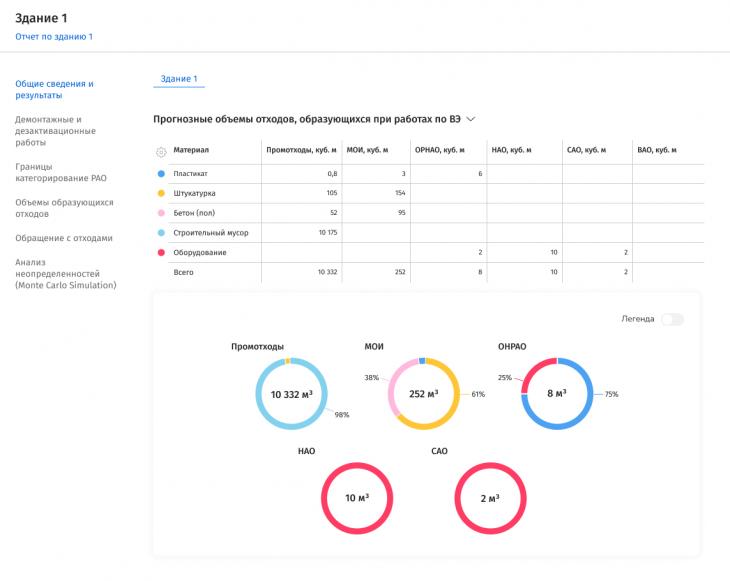
Figure 4 – Demonstration of a part of the program interface with visualization of the results of estimating the volume of waste generation by type and category* *MY – Restricted materials In accordance with the criteria for categorizing waste from documents [11, 12], based on the mass-dimensional characteristics of building elements and equipment, area, depth and characteristics of pollution, waste volumes are estimated by category. The method of performing calculations in the absence of complete and reliable data of radiation measurements on the surfaces of building structures is based on statistical methods. With the appearance of new data, the methodology is developing, its first version is presented in the publication [5]. The results of the calculations of the software module "Forecasting the volume of waste generation by types and categories" for YAROO are shown in Figure 4. Reference books with parameters characterizing the physical properties of various materials are also formed for calculations. Formation of technological processes and assessment of the cost of waste managementFor each type and category of waste, it is necessary to form a technological process for the safe handling of them (bringing them to the criteria of acceptability for burial, transportation, temporary storage and burial). For these purposes, the software provides a module "Designer for the formation of technological processes for waste management" (Figure 5). In the constructor for various categories and types of waste, a sequential set of operations (technologies) is formed in the form of a flowchart up to the disposal of waste, indicating the formation of new (secondary) waste.
The application has a database of various technologies with an indication of the necessary infrastructure (equipment, installations) for its implementation, waste parameters to which this technology is applicable, indicators of changes in waste volumes after the implementation of the technology, their characteristics, etc. Based on the market analysis, prices for various technologies and the cost of purchased packaging are partially formed (a detailed overview of the Russian and international markets for the cost of handling RAW is presented in [13]). The parameters for changing the volume of waste, their contamination, and the formation of new types of waste are also specified in the constructor, as shown in Figure 5. 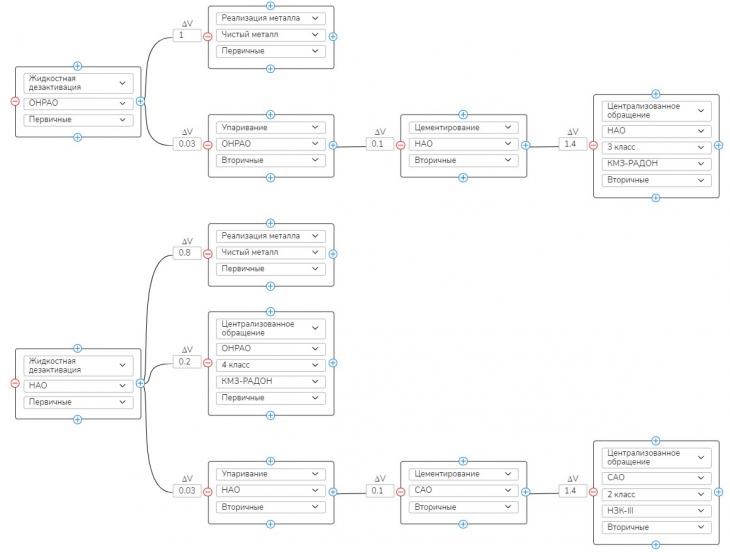
Figure 5 – Demonstration of a part of the program interface with visualization of the results of assessing the volume of waste generation by type and category (MINE are materials of limited use) As a result, a list of waste management operations of various types and categories is formed, according to the results of each operation, the volumes of waste generated are recalculated (due to the fact that the prices for the treatment of RW are determined by 1 cubic meter of waste) and the cost of each operation is estimated. After the completion of the RW conditioning stage, the required amount of packaging for disposal is calculated and their purchase price is estimated. At the final stage, depending on certain places of temporary storage and burial, transportation costs, costs for temporary storage of waste (before burial) and the cost of transfer to burial are estimated in accordance with tariffs for certain classes of waste (Order of the Federal Antimonopoly Service [14]). The obtained results of the assessment of the cost of handling the generated waste are aggregated into a common table and visualized in the software. Analysis of uncertainty and sensitivity of estimatesDespite the use of BIM technologies when performing calculations to systematize data on the nuclear power plant, there remains a fairly large set of uncertainty factors affecting the accuracy of estimating the cost of the project for the decommissioning of the nuclear power plant. Such factors include: - error of measuring instruments; - errors of the applied approximation models; - insufficient sample size and measurements to obtain unambiguous conclusions; - lack of data, due to the complexity and high cost of obtaining them; - stochasticity (randomness) of some processes; - the presence of market, financial, macroeconomic and other risks affecting prices; - insufficient experience in implementing technologies and resulting uncertainties. In the software being developed, the uncertainty analysis of the calculation results is performed on the basis of Monte Carlo simulation. At the same time, for each investigated parameter (source of uncertainty), a distribution law is established with parameter estimates based on various methods of mathematical statistics (in detail in the scientific article [15]). Ranges of variation (confidence intervals with specified probabilities) are calculated for forecasts of the formation of RW, the amount of packaging required for burial, the volumes of RW transferred to burial and all cost indicators. Visualization of the results of the uncertainty analysis in the program is shown in Figure 6. To analyze the sensitivity of the estimates obtained, the methods of correlation and regression analysis and the Sobol Method (indices of the 1st order and full contribution) are used [16]. Such an analysis allows us to identify variables that have a significant impact on the result, which will subsequently allow us to focus on the accuracy of their receipt, and vice versa – weakly influencing variables that can be fixed. 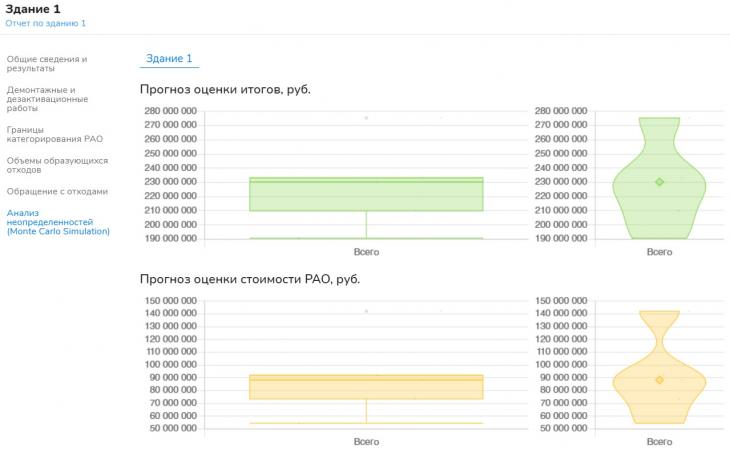
Figure 6 – Demonstration of a part of the program interface with visualization of the results of uncertainty analysis Results and conclusions At the moment, high-quality collection and analysis of data on nuclear waste at the preparatory stage, the choice of effective technologies for dismantling and decontamination works and the management of radioactive waste seem necessary to improve the efficiency of individual decommissioning projects and the Federal Target Program NRS-2 as a whole. For these purposes, it is advisable to apply BIM technologies and develop methods of financial and economic planning using data from information models of objects. All necessary calculations should be performed in specialized software, the functionality of which was developed point-by-point for solving the tasks of the final stages of the nuclear fuel cycle and is not available in the programs used in general practice for carrying out estimated calculations. At the moment, the following tasks are being solved for the further development of the software: - constant monitoring and updating of data, search and replenishment of the database with new reference information is carried out; - mathematical methods and algorithms for performing calculations are being improved, new patterns and dependencies are being searched, new models are being developed, hypotheses and assumptions are being refined; - the practical experience of decommissioning works is being investigated, information about existing and developing technologies and installations is being collected; - algorithms of application interaction with BIM are being developed;
- the architecture and code of the program are optimized to increase the speed of calculations. On the basis of the developed application, a multivariate analysis and justification of the optimal final state of the organizations of the Rosatom State Corporation that were stopped by the Nuclear power Plant, the decommissioning of which is planned within the framework of the Federal Target Program YARB-2, was carried out.
References
1. Federal target program "Ensuring nuclear and radiation safety for 2008 and for the period up to 2015" (FTP NRS – 1) [Electronic resource] (In Russ.). Available at: http://xn---2030-bwe0hj7au5h.xn--p1ai/about/archiv/ (accessed 08.09.2021)
2. Federal target program "Ensuring nuclear and radiation safety for 2016-2020 and for the period up to 2035" (FTP NRS – 2) [Electronic resource] (In Russ.). Available at: http://xn---2030-bwe0hj7au5h.xn--p1ai/ (accessed 08.09.2021)
3. IAEA Data Analysis and Collection for Costing of Research Reactor Decommissioning / IAEA. 2017. 126 p. Available at: https://www-pub.iaea.org/MTCD/Publications/PDF/TE1832_web.pdf (accessed 15.10.2021)
4. OECD Costs of Decommissioning Nuclear Power Plants / OECD. 2016. 260 p. Available at: https://www.oecd-nea.org/upload/docs/application/pdf/2019-12/7201-costs-decom-npp.pdf (accessed 15.10.2021)
5. Alexandrova T. A., Ivanov A. Yu., Linge I. I. [et al.]. Estimation of the volume of RW formation from decommissioning using information models. Radioactive waste. 2020. № 3(12). P. 19-31. (In Russ.)
6. On the creation of an integrated information model to determine the development strategy for the industrial complex for radioactive waste management FSUE "RADON" / A. V. Luzhetsky, Yu. V. Nevrov, M. V. Vedernikova [et al.] // Radioactive waste. 2020. № 1 (10). P. 101—112. (In Russ.)
7. PLEIADES, the Smarter Plant Decommissioning [Electronic resource] (In Russ.). Available at: https://pleiades-platform.eu/
8. Order of the Ministry of Construction and Housing and Communal Services of the Russian Federation dated August 4, 2020 No. 421/pr "On approval of the Methodology for determining the estimated cost of construction, reconstruction, Capital repairs, Demolition of capital construction facilities, works on the preservation of cultural heritage objects (Historical and cultural monuments) of the Peoples of the Russian Federation on the Territory of the Russian Federation", Garant [Electronic resource] (In Russ.)
9. Order of the Ministry of Construction and Housing and Communal Services of the Russian Federation dated September 4, 2019 N 507/pr "On approval of Methodological recommendations for the application of estimated standards", Garant [Electronic resource] (In Russ.).
10. Order of the Ministry of Construction and Housing and Communal Services of the Russian Federation dated September 4, 2019 N 519/pr "On approval of methodological recommendations for the application of federal unit prices for construction, special construction, repair and construction, installation of equipment and commissioning". Garant [Electronic resource] (In Russ.).
11. SP 2.6.1.2612-10 – Basic sanitary rules for Radiation Safety (OSPORB-99/2010) (as amended. Changes N 1, approved. By the Resolution of the Chief State Sanitary Doctor of the Russian Federation of 16.09.2013 N 43): Sanitary rules and regulations. Garant [Electronic resource] (In Russ.).
12. On the criteria for classifying solid, liquid and gaseous waste as radioactive waste, criteria for classifying radioactive waste as special radioactive waste and as radioactive waste to be disposed of and criteria for Classifying radioactive waste to be disposed of [Text]: Decree of the Government of the Russian Federation No. 1069 of October 19, 2012. Collection of Legislation of the Russian Federation. 2012. No. 44. Article 6017. (In Russ.)
13. Ilyasov D. F., Ivanov A. Yu., Kuznetsova E. O., Budunova A. S., Stepanyan P. O., Mikhailenko A. A. Comparative analysis of the cost of operations for the management of RW on the Russian and international markets. Radioactive waste. 2020. № 4 (13). P. 14-21. (In Russ.)
14. On the establishment of tariffs for the disposal of radioactive waste of Classes 1, 2, 3, 4, 6 for the period from 2018 to 2022 and tariffs for the disposal of radioactive waste of Class 5 for 2018 [Text]: Order of the Federal Antimonopoly Service of December 28, 2017 No. 1812/17 (as amended on November 15, 2018). Official Internet portal of legal information. Available at: www.pravo.gov.ru , N 0001201803060041 (accessed 11.09.2021). (In Russ.)
15. Methods of estimating the cost of radioactive waste management in the conditions of uncertainty of initial data. Radioactive waste. 2022. №1(18). C.16-27. (In Russ.)
16. Savelyeva E. A., Svitelman V. S., Blinov P. D. [et al.] On the choice of a method for assessing the sensitivity of the model to its parameters when justifying the safety of RAO disposal sites. Radioactive waste. 2021. № 2(15). P. 73-89. (In Russ.)
Peer Review
Peer reviewers' evaluations remain confidential and are not disclosed to the public. Only external reviews, authorized for publication by the article's author(s), are made public. Typically, these final reviews are conducted after the manuscript's revision. Adhering to our double-blind review policy, the reviewer's identity is kept confidential.
The list of publisher reviewers can be found here.
The article submitted for review examines the issues of digitalization of economic processes and software development for estimating the cost of projects related to the elimination of nuclear and radiation hazardous facilities. The research methodology is based on the study and generalization of literature sources on the topic of the work, the use of digital modeling methods and software development to solve the economic problem under consideration of estimating the cost of projects for the elimination of nuclear and radiation hazardous facilities. The author of the article rightly associates the relevance of the work with the fact that for the sustainable development of nuclear energy in the future, it is necessary to solve the problem of handling spent nuclear fuel and radioactive waste, as well as the elimination of nuclear and radiation hazardous facilities whose operation has been discontinued. The scientific novelty of the reviewed study, according to the reviewer, consists in proposals to improve the information model of buildings in the nuclear power industry, which allows to systematize data on the building structures of the facility, their mass-dimensional characteristics, the state and degree of contamination and other significant characteristics, as well as the development of a computer program with visualization of the results of the cost assessment of dismantling and decontamination works. The following sections are structurally highlighted in the article: Introduction, Assessment of the cost of dismantling and decontamination works, Forecasting the volume of waste generation by type and category, Formation of technological processes and assessment of the cost of waste management, Analysis of uncertainty and sensitivity of estimates, Results and conclusions, Bibliography. The author examines the technologies of digital 3D and information modeling of objects, data sources for building BIM (building information model), provides a view of the radiation pollution cartogram in BIM, built by interpolation based on pollution points from integrated engineering and radiation control, outlines the tasks solved using the proposed software, demonstrates the program interface with visualization of the results estimates of the cost of dismantling and decontamination works, as well as the results of assessing the volume of waste generation by type and category. The analysis of uncertainty and sensitivity of estimates was carried out taking into account such factors as the error of measuring instruments; errors of the applied approximation models; insufficient sample size and measurements to obtain unambiguous conclusions; lack of data, due to the complexity and high cost of obtaining them; stochasticity (randomness) of some processes; the presence of market, financial, macroeconomic and other risks affecting pricing; insufficient technology implementation experience and resulting uncertainties. The bibliographic list includes 16 sources – publications of Russian scientists on the topic of the article, normative materials and Internet resources. The text contains targeted references to literary sources confirming the existence of an appeal to opponents. As a remark, it can be noted that the numbering of formulas is performed with a deviation from generally accepted rules, and abbreviations in a foreign language are used in the text without their literal transcriptions. The reviewed material corresponds to the direction of the journal "Theoretical and Applied Economics", has been prepared on an urgent topic, reflects the results of a study conducted to assess the cost of projects for the elimination of nuclear and radiation hazardous facilities based on the proposed software. The presented material contains generalizations on the topic under consideration, may arouse the interest of readers, and therefore it is recommended for publication.
Link to this article
You can simply select and copy link from below text field.
|





